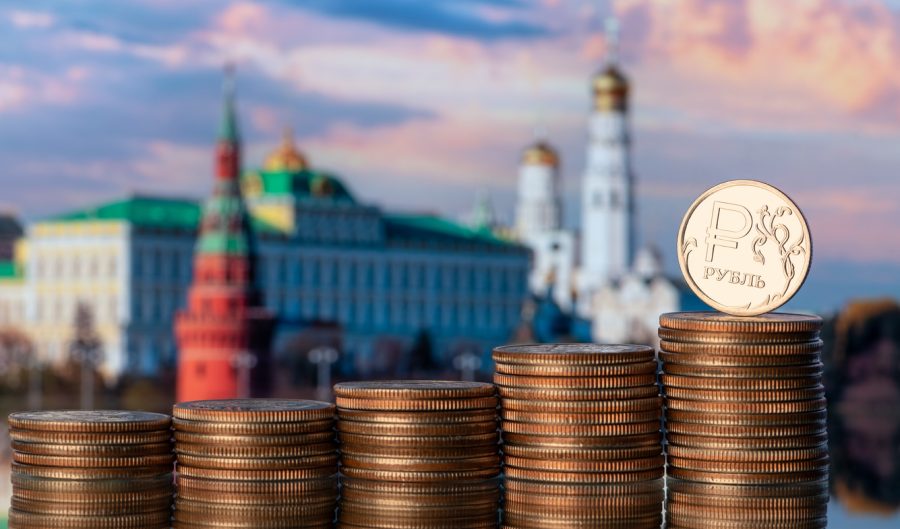The Central Bank of Russia raised its benchmark rate to a twenty-year high of 21 per cent on Friday – and has indicated that it could go even higher. Even Vladimir Putin, a notorious serial boaster, won’t be caught bragging about this tell-tale sign of a not-so-healthy economy. The writing is on the wall: Russia is getting closer to stagflation – a no-growth, high-inflation economy.
An interest rate this high is unprecedented. In February 2003, still fresh in his job, Putin launched reforms to kick-start the Russian economy after the 1998 financial meltdown; the central bank brought its refinancing rate to 20 per cent and has kept it below that level ever since – until now. Even in the days after Russia’s full-scale invasion of Ukraine in 2022, rates went no higher than 20 per cent.
The economy is running at full capacity and it’s unable to meet rising demand with higher production
The main reason for the decision to raise the interest now was recent fiscal clarity in the government budget over a massive hike in regulated utility tariffs and state spending plans for 2024 and 2025. This was driven mainly by military expenditure (the 2024 budget deficit is expected to be 3.3 trillion rubles (£26 billion) or 1.7 per cent of GDP, compared to with a planned 0.9 per cent).
In its statement, the Central Bank said that it ‘allows for the possibility of raising the base rate at the next meeting’. Based on its forecast for the average rate at the end of this year (21-21.3 per cent), the Central Bank is prepared to contemplate a rate rise to 23 per cent at December’s meeting (the final one of the year).
But despite the regulators’ efforts to raise interest rates and take the heat out of the economy, inflation has not slowed. The Central Bank now believes that inflation in 2024 will be between 8 and 8.5 per cent (compared with its previous forecast of 6.5 to 7 per cent). Inflationary expectations, which the bank monitors closely, increased from 12.5 per cent to 13.4 per cent across the entire range of respondents, both individual and corporate, in the most recent October survey.
Moreover, despite sky-high rates, the regulator also has higher expectations for lending growth. In September, corporate loans were up 2 per cent, or 1.6 trillion rubles (£12.7 billion), on the previous month after a 1.9 per cent rise in August. So far this year, outstanding corporate borrowing has grown by 14.5 per cent despite high borrowing costs. The lion’s share of corporate borrowing is, however, state-subsidized and goes towards the military industry and import substitution. The level of consumer borrowing is also rising, albeit slowly – the rate at which it is rising dropped to 0.7 per cent month on month in September from 1.3 per cent in August.
Consumers are borrowing more because their salaries are rising. This is happening thanks to a constant shortage of workers fueled by demands of the army and the defense industry, suddenly making employees more creditworthy. On the corporate side, this creates a precarious situation: companies are feeling the double pressure of raising salaries further to attract workers and finding money to cover loan interest payments.
The economy is running at full capacity, though, and it’s unable to meet rising demand with higher production. The result of this is sticky inflation. Seasonally adjusted inflation was up from 7.5 per cent to 9.8 per cent in September. Added to this, there is a high risk of continuing rapid price increases for food primarily due to this year’s poor harvest.
Facing high rates, many companies will soon be forced to stop investing in their own expansion. Instead, they will have to spend that money maintaining production facilities and keeping up with workers’ salary expectations. Debt-laden enterprises that are not fortunate enough to have their loans subsidized by the state, and are therefore sensitive to high interest rates, might be unable to refinance their loans and could then face bankruptcy.
At the core of the problem is rising government spending across the board, both directly and via subsidised loans, on the war effort and the constant shortage of workers. Russia entered the war in Ukraine laden with a difficult demographic situation thanks to a declining working population caused by the low birthrate in the turbulent 1990s. The army and the burgeoning defence industry need more boots on the ground and hands on the factory floors. On top of that, the inflow of migrant workers that was so regular over the past few decades is drying up thanks to the state’s security concerns and fears of upsetting the Russian population, no longer so keen on accommodating more foreigners from Central Asia. Western sanctions are also limiting technological advances and access to the international borrowing market, both of which are crucial for a productivity surge.
The result of this is that the Central Bank and the government are behaving much like the double-headed eagle emblazoned on the Russian state seal: they are staring in opposite directions. The Central Bank, responsible for keeping inflation at bay, needs to raise interest rates. However, government war-related spending is making inflation worse. Production data from August and September show that almost every non-war related industry grew at an anaemic rate at best.
Like the Soviet Union before it, the Russian economy could enter a period of ‘inflation without growth’. The outlook for this year is still healthy: the Kremlin expects the economy to register 3.9 per cent annual growth. However, next year, the government expects growth to slow to 2.5 per cent, which might well even be too optimistic, given the World Bank’s projection of 1.7 per cent and the IMF’s 1.3 per cent.
For the moment, the Russian economy has not fallen into stagflation, a dangerous situation in which the economy grows slowly and prices shoot up fast. But it’s getting closer.






Comments